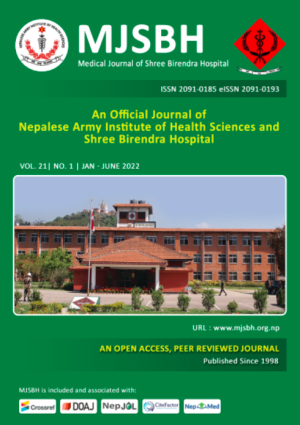Bacteriological Profile of Chronic Dacryocystitis in a Tertiary Hospital in Nepal
DOI:
https://doi.org/10.3126/mjsbh.v21i1.39542Abstract
Introduction: Chronic dacryocystitis is a common cause of epiphora resulting from nasolacrimal duct obstruction. We planned to study bacteriological profile of chronic dacrocystitis in a tertiary hospital in Kathmandu, Nepal.
Methods: This is a prospective study conducted patients with CDC who underwent external dacryocystorhinostomy in Shree Birendra Hospital from September 2018 to September 2019. A structured proforma was used to record all necessary information of all patients.
Results: A total of 90 eyes were included, 56 females and 34 males. The commonest organism isolated from conjunctiva was Staphylococcus Epidermidis whereas Staphylococcus Aureus and Staphylococcus Epidermidis were the commonest isolates from the lacrimal sac. All organism isolated from conjunctiva showed highest percentage of sensitivity to ceftriaxone and least sensitivity to ampicillin whereas Staphylococcus aureus and Staphylococcus Epidermidis from lacrimal sac specimen showed highest sensitivity to ceftriaxone and least sensitivity was seen with gentamycin. External dacryocystorhinostomy with silicon tube resulted into a success rate of 90%.
Conclusions: The knowledge of common organism causing chronic dacryocystitis helps in selecting antimicrobial prophylaxis in lacrimal drainage surgery. Furthermore it also helps in determining the role of commensal flora in pathogenesis of CDC. Ceftriaxone is the most sensitive drug for the microbials of chronic dacryocystitis. External dacryocystorhinostomy is cheaper, technically easier surgical procedure with good success rate.
Downloads
Downloads
Published
How to Cite
Issue
Section
License
Copyright (c) 2022 Medical Journal of Shree Birendra Hospital

This work is licensed under a Creative Commons Attribution-NonCommercial-NoDerivatives 4.0 International License.
This license enables reusers to distribute, remix, adapt, and build upon the material in any medium or format for noncommercial purposes only, and only so long as attribution is given to the creator.




